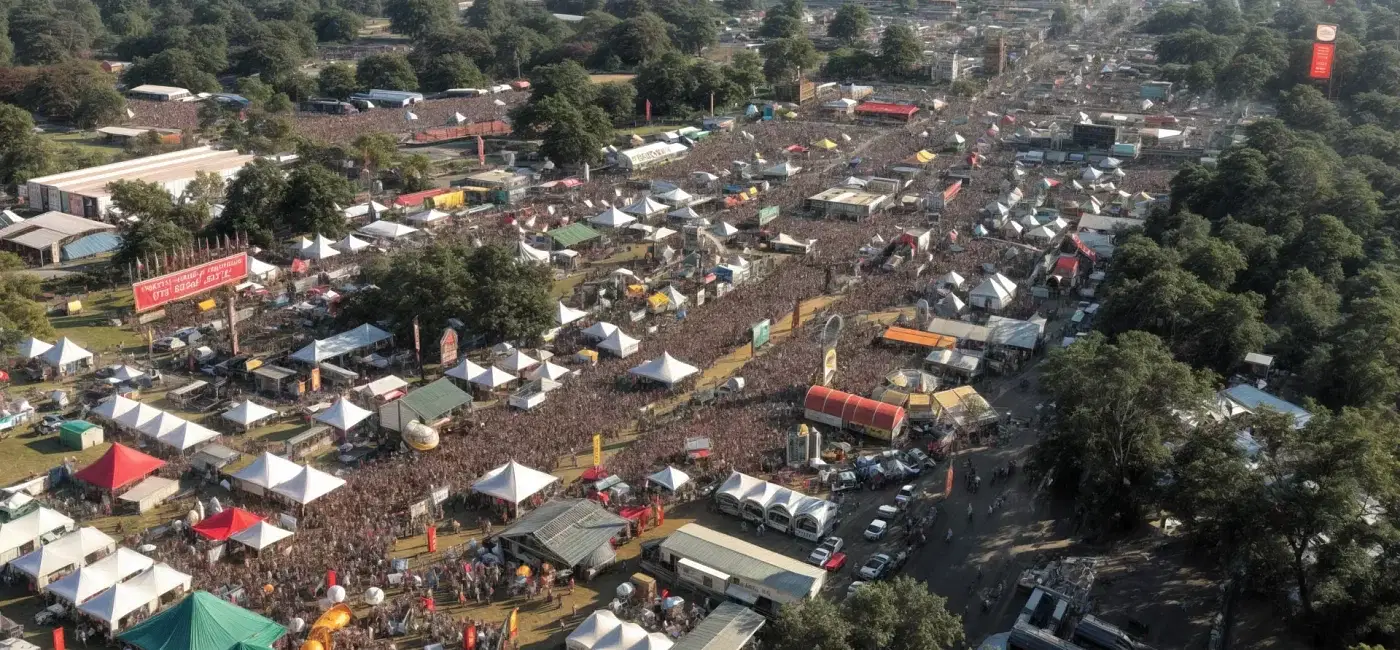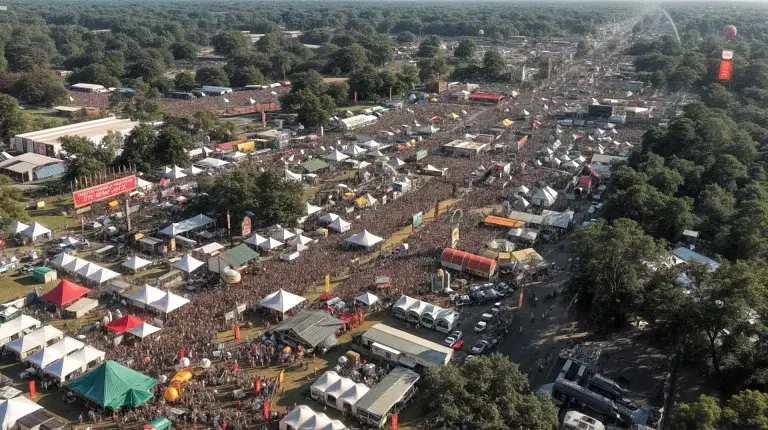Picture this: It’s a perfect summer evening. The air buzzes with excitement as thousands of concert-goers stream into a massive outdoor venue. The stage is set, the lights are dazzling, and the anticipation is palpable. But beneath the surface of this spectacle lies a less glamorous reality – mountains of trash, energy-guzzling equipment, and a carbon footprint that would make even the most ardent climate change denier wince.
Welcome to the world of large-scale event management, where the show must go on, but increasingly, so must sustainability. As we hurtle towards a future where “eco-friendly” isn’t just a buzzword but a necessity, venue managers are finding themselves in the spotlight, tasked with the Herculean feat of making fairs and concerts as green as the grass they’re held on.
In this deep dive, we’ll explore how the events industry is turning over a new leaf (pun absolutely intended) and implementing eco-friendly practices that would make Mother Nature proud. So grab your reusable water bottle, don your bamboo sunglasses, and let’s embark on this journey towards a greener, cleaner future in venue management.
The Wake-Up Call
For years, the mantra of the events industry seemed to be “bigger is better.” Massive stages, pyrotechnics that could be seen from space, and enough plastic cups to build a life-size replica of the Taj Mahal. But as the world started to wake up to the realities of climate change, so too did event organizers and venue managers.
The statistics were sobering. A single large music festival could generate up to 500 tons of waste. The carbon footprint of a major concert tour could rival that of a small country. And let’s not even get started on the water usage – enough to make a desert oasis look like a drop in the bucket.
It was clear that something had to change. The question was: how do you make an industry built on excess and spectacle suddenly embrace minimalism and sustainability?
The answer, as it turns out, was a mix of innovation, determination, and a healthy dose of public pressure. After all, nothing motivates change quite like the prospect of angry tweets from environmentally conscious fans.
Energy: Powering the Show Without Powering Down the Planet
One of the biggest challenges in making events sustainable is dealing with the enormous energy consumption. From stage lights to sound systems, concerts and fairs are veritable power-hungry beasts.
But innovative venue managers are finding ways to tame these energy monsters. Solar panels are popping up on venue roofs faster than you can say “renewable energy.” Windmills are being integrated into festival sites, providing both power and a convenient meeting point for lost revelers.
Some forward-thinking venues have even started experimenting with kinetic dance floors. That’s right – the very act of dancing is being harnessed to generate electricity. It gives a whole new meaning to “dance like nobody’s watching” when your moves are literally keeping the lights on.
But it’s not just about generating clean energy; it’s also about using less of it. LED lighting systems are replacing traditional energy-guzzling bulbs, cutting power consumption by up to 80%. And smart power management systems ensure that energy is used efficiently, preventing wastage during off-peak hours.
Waste Management: From Trash to Treasure
If you’ve ever been to a large event, you know that the aftermath can look like a scene from a post-apocalyptic movie. Plastic cups as far as the eye can see, food wrappers blowing in the wind like tumbleweeds, and enough discarded glow sticks to light up a small city.
But venue managers are getting creative in their fight against waste. Reusable cup systems are becoming increasingly common, with festival-goers paying a small deposit for a cup they can use throughout the event and return at the end. It’s like a grown-up version of the piggy bank, except instead of saving pennies, you’re saving the planet.
Composting stations are popping up alongside recycling bins, turning food waste into nutrient-rich soil. Some venues have even partnered with local farms, creating a circular economy where yesterday’s hamburger bun becomes tomorrow’s fertilizer for the wheat field.
And let’s not forget about the unsung heroes of waste management – the humble bin. Gone are the days of the solitary, overflowing trash can. Modern venues are equipped with clearly labeled, strategically placed waste stations that make sorting trash as easy as deciding which band merch to buy.
Water Conservation: Making Every Drop Count
In the world of large events, water usage can be, well, a bit of a waterfall. From keeping the grass green to keeping the punters hydrated, venues can go through more water in a weekend than a small town does in a month.
But savvy venue managers are turning off the taps on wasteful practices. Low-flow fixtures in bathrooms are becoming standard, cutting water usage without sacrificing hygiene. (Because let’s face it, no one wants to sacrifice hygiene at a crowded event.)
Rainwater harvesting systems are being installed, capturing nature’s bounty to water grounds and flush toilets. It’s like having a giant water cooler, courtesy of the sky.
Some venues are even experimenting with waterless urinals. It’s a concept that might make some squeamish, but when you consider that a single traditional urinal can use up to 40,000 gallons of water a year, suddenly it doesn’t seem so crazy.
Transportation: Getting There Green
The environmental impact of an event doesn’t start when the first note is played or the first corn dog is sold. It begins the moment attendees start making their way to the venue.
Progressive venue managers are tackling this issue head-on. Many are partnering with public transport providers to offer integrated ticketing – your event ticket doubles as your bus or train pass. It’s like a two-for-one deal, except instead of getting an extra slice of pizza, you’re getting a reduced carbon footprint.
Bike parking areas are being expanded, often with the added incentive of priority entry for cyclists. Nothing motivates people to pedal quite like the promise of skipping the queue.
For those who must drive, carpooling initiatives and electric vehicle charging stations are becoming commonplace. Some venues are even experimenting with biodiesel shuttles, powered by the very cooking oil used to fry up those delicious festival snacks. Talk about coming full circle!
Food and Beverage: Sustainable Sustenance
Gone are the days when event food meant a sad hot dog and a lukewarm beer. Today’s venue managers are serving up sustainability alongside culinary delights.
Local sourcing is becoming the norm, with venues partnering with nearby farms and producers. It not only reduces transportation emissions but also supports local economies. Plus, it gives event-goers a taste of the region – literally.
Plant-based options are sprouting up on menus faster than you can say “veggie burger.” It’s not just about catering to vegetarians and vegans anymore; it’s about recognizing the enormous environmental impact of meat production.
Even the humble festival beer is getting a green makeover. Many venues are partnering with local breweries that use sustainable practices, or even setting up on-site microbreweries. Because nothing says “eco-friendly” quite like a beer that’s traveled fewer miles than you have to get to the event.
Eco-Friendly Materials: Building a Greener Stage
When it comes to event infrastructure, sustainability is becoming built-in – quite literally. Stages and temporary structures are increasingly being made from recycled or sustainable materials. Bamboo, reclaimed wood, and even mushroom-based materials are taking center stage.
Signage is going digital, reducing the need for paper and plastic. And when physical signs are necessary, they’re often made from recyclable or biodegradable materials. It’s like a magic trick – now you see it, now you don’t (because it’s composted back into the earth).
Even the small details are getting the green treatment. Lanyards made from recycled plastic bottles, wristbands from bamboo fiber, and staff uniforms from organic cotton are becoming the norm. It’s like a fashion show where the theme is “Save the Planet.”
Education and Engagement: Spreading the Green Gospel
Smart venue managers know that true sustainability isn’t just about what they do – it’s about inspiring attendees to join in the eco-friendly fun.
Many events now feature sustainability zones, where attendees can learn about environmental issues and pick up tips for greener living. It’s like a mini eco-conference nestled within your favorite music festival.
Some venues are gamifying sustainability, offering rewards for eco-friendly behaviors. Recycle a certain number of items? Get a free drink. Use public transport to arrive? Priority entry could be yours. It turns being green into a game where everyone wins – especially the planet.
Social media campaigns are being leveraged to spread awareness before, during, and after events. Hashtags like #GreenConcert or #EcoFair encourage attendees to share their sustainable actions, creating a ripple effect of environmental consciousness.
Measuring and Reporting: Keeping Score on Sustainability
In the world of sustainability, if you can’t measure it, you can’t manage it. Progressive venue managers are embracing this philosophy, implementing comprehensive systems to track their environmental impact.
Energy meters, waste audits, and water usage trackers are becoming as common as ticket scanners. Some venues are even calculating the carbon footprint of individual events, offsetting what they can’t reduce.
But it’s not just about collecting data – it’s about sharing it. Many venues are publishing sustainability reports, laying bare their environmental impact and their efforts to reduce it. It’s a level of transparency that would make a glass house look opaque.
This data isn’t just for show – it’s being used to set ambitious targets for future improvements. Because in the race to save the planet, standing still is the same as moving backwards.
Challenges and Future Directions
Of course, the path to sustainability isn’t always smooth. Venue managers face numerous challenges in their quest to go green.
Cost is often cited as a barrier, with some eco-friendly solutions requiring significant upfront investment. But savvy managers are finding that many sustainable practices actually save money in the long run. It turns out that what’s good for the planet can also be good for the bottom line.
There’s also the challenge of changing deeply ingrained behaviors – both of staff and attendees. Old habits die hard, and convincing everyone to embrace new, greener ways of doing things can be an uphill battle. But with persistence, education, and a dash of incentivization, minds are being changed and habits are being formed.
Looking to the future, the possibilities are exciting. Imagine events powered entirely by renewable energy, with zero waste sent to landfill. Picture venues that are carbon-neutral or even carbon-negative, actively helping to clean the air around them.
We might see the rise of “pop-up” sustainable venues – temporary structures that leave no trace when the event is over. Or perhaps “virtual” elements will become more prevalent, allowing people to attend events remotely and reducing the need for travel.
The technology of sustainability is advancing rapidly, and with it, the potential for even greener events. From biodegradable glitter (because who doesn’t love a bit of sparkle?) to AI-powered waste sorting systems, the future of eco-friendly events is limited only by our imagination.
Conclusions
As we’ve seen, sustainability in venue management is no longer a nice-to-have – it’s a must-have. From the energy that powers the speakers to the food that fuels the fans, every aspect of event management is being reimagined through a green lens.
But perhaps the most exciting aspect of this sustainability revolution is its potential to influence behavior beyond the event itself. Every person who uses a reusable cup at a festival, or cycles to a concert, is learning habits that they can take back into their daily lives.
In this way, sustainable venues are becoming more than just places of entertainment – they’re becoming catalysts for wider social change. They’re proving that it’s possible to have a great time without costing the earth, quite literally.
So the next time you’re at a concert or a fair, take a moment to look around. That solar panel glinting in the sun, that volunteer patiently explaining which bin to use, that locally-sourced veggie burger you’re munching on – they’re all part of a quiet revolution that’s transforming the events industry from the inside out.
The show must go on, yes. But thanks to the efforts of innovative venue managers and the support of environmentally conscious event-goers, it’s going on in a way that’s kinder to our planet. And that’s something we can all cheer for – sustainably, of course.








